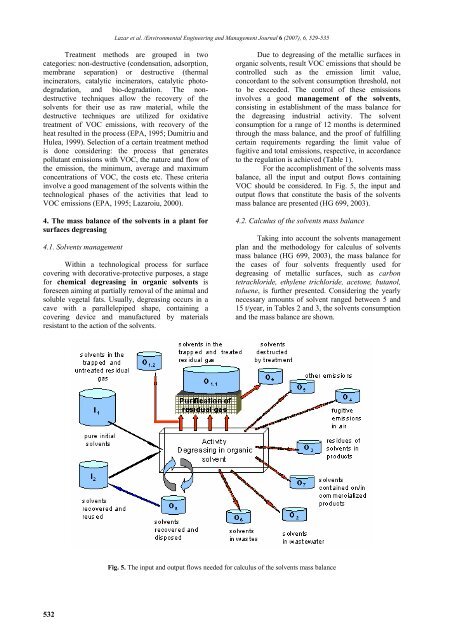2007_6_Nr6_EEMJ
Create successful ePaper yourself
Turn your PDF publications into a flip-book with our unique Google optimized e-Paper software.
Lazar et al. /Environmental Engineering and Management Journal 6 (<strong>2007</strong>), 6, 529-535<br />
Treatment methods are grouped in two<br />
categories: non-destructive (condensation, adsorption,<br />
membrane separation) or destructive (thermal<br />
incinerators, catalytic incinerators, catalytic photodegradation,<br />
and bio-degradation. The nondestructive<br />
techniques allow the recovery of the<br />
solvents for their use as raw material, while the<br />
destructive techniques are utilized for oxidative<br />
treatment of VOC emissions, with recovery of the<br />
heat resulted in the process (EPA, 1995; Dumitriu and<br />
Hulea, 1999). Selection of a certain treatment method<br />
is done considering: the process that generates<br />
pollutant emissions with VOC, the nature and flow of<br />
the emission, the minimum, average and maximum<br />
concentrations of VOC, the costs etc. These criteria<br />
involve a good management of the solvents within the<br />
technological phases of the activities that lead to<br />
VOC emissions (EPA, 1995; Lazaroiu, 2000).<br />
4. The mass balance of the solvents in a plant for<br />
surfaces degreasing<br />
4.1. Solvents management<br />
Within a technological process for surface<br />
covering with decorative-protective purposes, a stage<br />
for chemical degreasing in organic solvents is<br />
foreseen aiming at partially removal of the animal and<br />
soluble vegetal fats. Usually, degreasing occurs in a<br />
cave with a parallelepiped shape, containing a<br />
covering device and manufactured by materials<br />
resistant to the action of the solvents.<br />
Due to degreasing of the metallic surfaces in<br />
organic solvents, result VOC emissions that should be<br />
controlled such as the emission limit value,<br />
concordant to the solvent consumption threshold, not<br />
to be exceeded. The control of these emissions<br />
involves a good management of the solvents,<br />
consisting in establishment of the mass balance for<br />
the degreasing industrial activity. The solvent<br />
consumption for a range of 12 months is determined<br />
through the mass balance, and the proof of fulfilling<br />
certain requirements regarding the limit value of<br />
fugitive and total emissions, respective, in accordance<br />
to the regulation is achieved (Table 1).<br />
For the accomplishment of the solvents mass<br />
balance, all the input and output flows containing<br />
VOC should be considered. In Fig. 5, the input and<br />
output flows that constitute the basis of the solvents<br />
mass balance are presented (HG 699, 2003).<br />
4.2. Calculus of the solvents mass balance<br />
Taking into account the solvents management<br />
plan and the methodology for calculus of solvents<br />
mass balance (HG 699, 2003), the mass balance for<br />
the cases of four solvents frequently used for<br />
degreasing of metallic surfaces, such as carbon<br />
tetrachloride, ethylene trichloride, acetone, butanol,<br />
toluene, is further presented. Considering the yearly<br />
necessary amounts of solvent ranged between 5 and<br />
15 t/year, in Tables 2 and 3, the solvents consumption<br />
and the mass balance are shown.<br />
Fig. 5. The input and output flows needed for calculus of the solvents mass balance<br />
532


